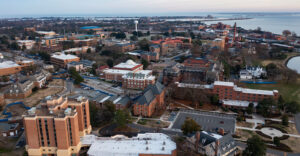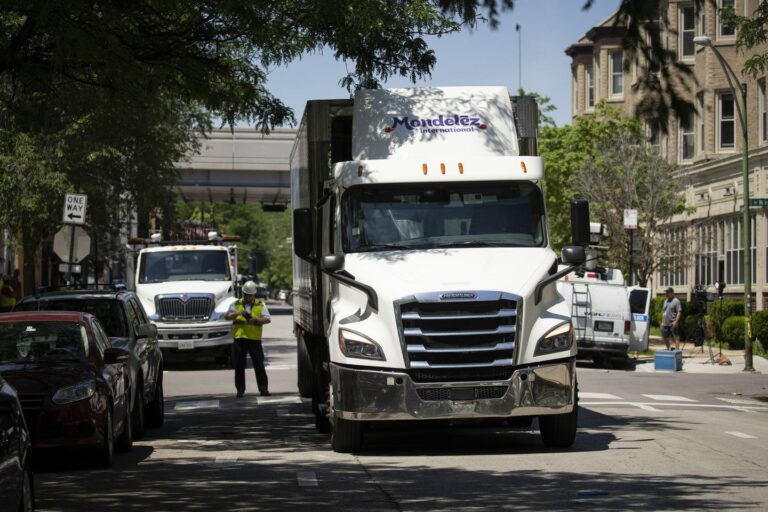Shortly before he was killed by a car while crossing the street, Peter Paquette attended a rally to educate people about the importance of voting early.
A longtime volunteer for the 47th Ward, Paquette, 75, was always working to make his community better, said Ald. Matt Martin, who shook hands with Paquette at the rally just before he died.
Advertisement
“He was just a terrific person and such a kind, thoughtful individual,” Martin said. “He was also someone who was incredibly passionate about the opportunities that government could create when doing things correctly.”
Paquette’s death was at least the third in recent weeks in Chicago in which a vehicle struck and killed someone, including two young children killed a week apart.
Advertisement
The fatalities unleashed anger among community members who on Sunday rallied on Leland Avenue for road improvements that would keep cyclists and pedestrians safer and shone a spotlight on city streets that are by and large not designed with foot and bike traffic in mind. Advocates are calling for citywide infrastructure that would prioritize the safety of pedestrians and cyclists, a sometimes politically fraught issue when some segments of the community push back due to fears of losing parking spaces and traffic lanes.
“Streets are currently designed mainly to move cars and trucks as quickly as possible,” said Kyle Whitehead, spokesperson for Active Transportation Alliance, an organization that advocates for safe and equitable walking, biking and public transportation. “I think that’s particularly upsetting in the city of Chicago, … a major, relatively dense, urban area with people walking and biking frequently to destinations.”
In the most recent fatality on Sunday, Paquette was killed around 5:15 p.m. when he was hit by a car while he crossed Irving Park Road in a crosswalk in the North Center neighborhood, police said.
Earlier, on June 2, a driver heading west in the 2200 block of West Eastwood Avenue hit and killed 2-year-old Raphael Cardenas,who went by Rafi, just before 6 p.m., according to Chicago police. The toddler had been crossing the street on a mini-scooter in his Lincoln Square neighborhood, police said.
One week later, on June 9, 3-year-old Lily Grace Shambrook was killed when a semitruck collided with the bicycle she was being carried on in the 1100 block of West Leland Avenue in Uptown, Chicago police said.
Earlier this year, 22-year-old bicyclist Nick Parlingayan was hit and killed by a vehicle that fled the scene in the 3800 block of North Milwaukee Avenue in the Old Irving Park neighborhood. At least two other cyclists have been killed in car collisions in 2022.
[ Deadly stretch of Milwaukee Avenue raises concern among cyclists as the season gets underway ]
Car crash deaths have risen in recent years, according to the U.S. Department of Transportation. A report released by the agency that tabulated early estimates of motor vehicle fatalities in 2021 found that such deaths increased by more than 10% over 2020. Pedestrian fatalities were up 13% and cycling fatalities 5% in 2021, according to the report.
Over the past 10 years, bike and pedestrian fatalities have made up an increasing share of traffic deaths, according to the Federal Highway Administration.
Advertisement
Pedestrian fatalities in the U.S. went from making up about 13% of total traffic deaths in 2010 to nearly 17% in 2019, according to the FHWA. Cycling fatalities also increased during the decade, rising from encompassing about 1.9% of all traffic deaths to 2.3% between 2009 and 2018.
In the Leland crash, the bicycle was hit when the cyclist was forced to maneuver around a ComEd truck that was parked in the bike lane, according to local media reports. The truck was cited for parking in a bicycle lane and within 30 feet of a stop sign, Chicago police said.
A spokesperson for ComEd said the utility company is still investigating the crash.
“The safety and security of ComEd customers and employees is always our top priority, and our thoughts are with the family,” a statement from the company read.
Cycling advocates point to a confluence of dangerous road conditions at play in the Leland crash, namely, a vehicle blocking a bike lane and trucks using Leland instead of larger crosstown roads like Wilson or Lawrence Avenue, where work on viaducts may play a role in rerouting trucks.
“Leland should be designed in a way that is physically impossible or extremely inconvenient for someone in a semitruck to go down that street,” Whitehead said.
Advertisement
In a statement sent to the Tribune, 46th Ward Ald. James Cappleman said his office earlier this year allotted funding to study traffic on Leland throughout his ward. Cappleman also said the ward has allocated money for curb extensions, or bump outs, at the intersection of Leland and Beacon Street. Installation should begin at the end of the month.
“Our thoughts remain with Lily, her mother, and our biking community,” Cappleman said in the statement.
In the days since Paquette and the toddlers were killed, calls for reform have grown, with a message that the roads are not just for cars, and should not be designed as such.
Experts point to vehicle speed as a major factor in whether a crash is fatal. A pedestrian struck by a vehicle traveling 20 miles per hour has a 90% chance of surviving, while a pedestrian struck by a vehicle traveling 40 miles per hour has a 20% chance, according to an analysis of federal data cited by the Chicago Metropolitan Agency for Planning.
Victoria Barrett, a transportation planner with CMAP, said measures like narrowing traffic lanes, adding speed bumps and tightening intersections by extending the curbs can help lower speeds, she said. So can city policy, like setting speed limits, she said.
“There are design features we can use on streets to make them less wide, less straight and less flat, which are the three things that drive higher speeds,” she said.
Advertisement
Also important is separating cyclists from drivers, particularly large, heavy vehicles like trucks because they have the potential to do more damage than smaller vehicles, Barrett said.
“If you can’t slow down vehicles reasonably, it’s important to separate vulnerable roadway users with things like bicycle lanes,” she said.
Experts and advocates also said the use of concrete barriers to separate bike lanes from vehicle lanes would protect bikers and deter motorists from parking in the bike lanes.
Where bike lanes are delineated only by paint, as they are in much of the city, cars often park in the lane or vehicles making deliveries block the lane, said Audrey Wennink, director of transportation for the Metropolitan Planning Council, who often commutes from her North Side home to her downtown office by bike.
Enforcement is part of the solution, she said, but making it physically impossible to block the lane with a concrete separation is key. Bike lanes also help narrow roadways, which lowers the speed of cars more effectively than setting speed limits, she said. Reducing the number of driving lanes and putting in medians to serve as islands for pedestrians crossing the street also narrows roadways.
Roads like Irving Park, where Paquette was struck and killed Sunday night, are particularly dangerous, Wennink said.
Advertisement
“Those are some of the worst roads for safety because they’re so many lanes,” she said. “People drive really fast, and we need to totally rethink how we design those roadways.”
These types of infrastructure measures reduce instances of human error, experts say, which decreases the risk of a tragic consequence for anyone using the road.
“We know people are going to make mistakes, so concrete bike lanes protect against mistakes,” said Kate Lowe, an associate professor in the department of urban planning and policy at the University of Illinois at Chicago who studies transportation.
In 2017, Chicago signed onto the international road safety project Vision Zero, and at the time established the goal of reducing roadway crashes and ultimately eliminating serious injuries and traffic deaths by 2026.
A statement from the Chicago Department of Transportation said Mayor Lori Lightfoot’s administration created a “dedicated funding stream” for safer streets as part of the Vision Zero program. CDOT said the city has installed more than 750 pedestrian safety projects in the last two years, including curb extensions and pedestrian refuge islands, and added 45 miles of new and upgraded bike lanes in 2021.
“Any tragedy is one too many and the City of Chicago takes a multidimensional approach to keeping our streets safe,” a CDOT spokesperson said in a statement. “Chicago is using all tools in the toolbox, including building our local infrastructure better to reduce conflict points between road users, using cameras to deter speeding, strengthening community partnerships to identify and program local safety initiatives, and creating and supporting policies to support the shift toward fewer vehicles and smaller vehicles in our city.”
Advertisement
Still, some experts, advocates and elected officials say the city needs to take a more comprehensive approach to installing bike and pedestrian infrastructure.
Martin, the 47th Ward alderman, said the city’s approach to bike safety has been piecemeal over the years.
“It really can’t continue to be something like 50 different approaches across the city, depending on who the alderperson is,” Martin said.
Advocates blame Chicago’s practice of allowing aldermanic privilege, which gives individual aldermen significant power in blocking or allowing infrastructure projects in their own wards. They say aldermen have outsize power to influence street-related projects, and often buckle to loud voices in their ward who push back on anything they perceive as inhibiting parking access or traffic flow.
Michael Podgers, an organizer for Better Streets Chicago, said street design should be purely influenced by safety-related best practices that are informed by data and research, rather than political concerns.
“We really have to actually have people who are in positions of power stick their necks out there and do the work and expend the political capital to make it happen,” Podgers said.
Advertisement
Overall, advocates and experts seek to change the way people view their roadways, working to reverse decades of a car-first approach.
“We need to change the whole culture of operating roads so that we’re prioritizing safety over speed,” Wennink said.
mabuckley@chicagotribune.com
sfreishtat@chicagotribune.com







